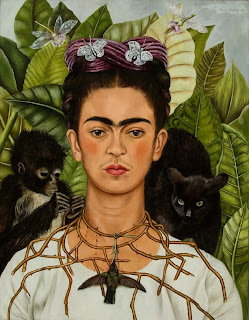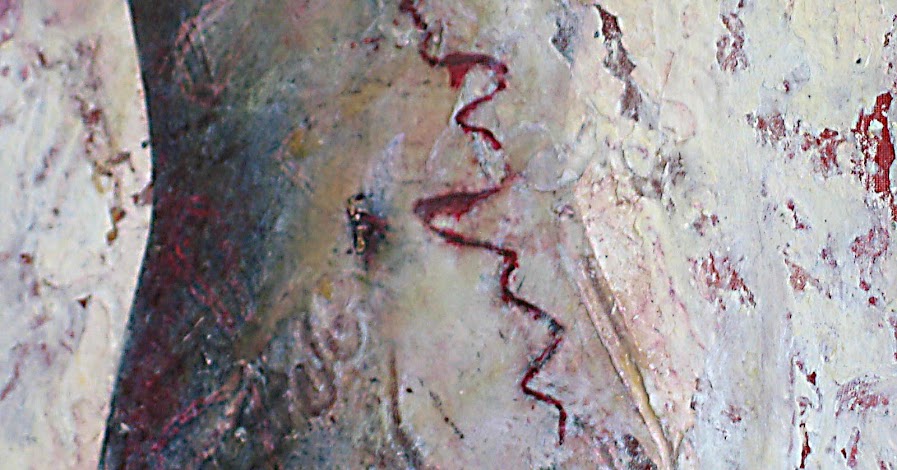This recent painting is about just that, a fantasy, a desire, the wish to be someone or something else. It symbolises the 'Hero' archetype, the 'Shadow', and the idealisation of the superhero. It's about that yearning to transcend our ordinary, perhaps boring lives, to embody something greater, something extraordinary where we feel respected and powerful.
The black suit - a mask, his heroic alter ego that he presents to the world - is also his 'Shadow'; his silent echoes, the aspects of himself he wishes to deny or hasn't yet awakened to. The painting tells a story of vulnerability squeezed into hiding by a façade of fantasy. In this portrayal of a young man, his longing to surpass his ordinary life is influenced by his cultural identity and the societal expectations that surround him.
Superheroes and the Power of Archetypes in Pop Culture
In the world of superheroes, costumes play a significant role. They are visual representations of the characters' identities, their powers, and their journeys. One of the most striking examples of this is Spider-Man's black and gold suit in the film 'No Way Home'.
Swiss psychiatrist Carl Jung, known for his exploration of the human psyche, didn't specifically discuss modern-day superheroes. However, his theories on archetypes, which are universal patterns or images residing in our collective unconscious, find relevance in superhero narratives as they tap into our deepest fantasies and desires.
The Hero's Journey: The Common Narrative in Superhero Stories
Archetypes, according to Jung's theory, are universal symbols, themes, or patterns that are deeply ingrained in the human psyche and shared across cultures. They represent fundamental human experiences and emotions that are part of our collective unconscious, meaning they are inherited and present in all of us. In superhero stories, these archetypal patterns often manifest as the hero's journey, the battle between good and evil, and the discovery of one's true identity. By recognizing and understanding archetypes, we gain insights into the deeper layers of storytelling and glimpses into our own lives within these captivating tales.
One of the key archetypes Jung identified is the 'Hero,' which aligns closely with the concept of a superhero. The Hero embarks on a journey, faces and overcomes challenges, often fights evil, and undergoes personal transformation. This Hero's Journey, as it's often called, is a common narrative in superhero stories.
Peter Parker's Transformation: Embracing the 'Shadow'
In the movie, 'No Way Home,' Peter Parker, aka Spider-Man, turns his red and blue suit inside out to reveal a black and gold version. This transformation of his iconic costume is more than just a very cool look I wish he'd held on to; it's a symbol of a darker time in Peter's life, a period marked by public mistrust and personal struggle. The alteration of his iconic costume serves as a visual metaphor for the internal conflict and transformation he undergoes during this pivotal part of the film's narrative.
This black suit can be seen as a manifestation of another Jungian archetype - the 'Shadow'. According to Jung, the 'Shadow' represents the darker, unconscious aspects of ourselves that we might deny or repress. In Peter's case, the act of turning the suit inside out to reveal the black suit, can be seen as a metaphor for bringing his 'Shadow' aspects to the surface, forcing him to confront and integrate them into his identity.
Discovering Ourselves Through the 'Shadow'
The 'Shadow' is not something negative to overcome, but a necessary part of our psyche to be acknowledged and accepted. Peter's journey in the black suit embodies this concept. It illustrates his internal struggle, a testament to the complexities of his character, and reminds us of the universal human experience of grappling with our darker sides.
In the realm of superheroes, Spider-Man's black suit stands out as a powerful symbol of the 'Shadow' archetype. It's a reminder that even in the world of superheroes, the journey towards self-understanding and transcendence is a crucial part of the story.
However, Spider-Man is not the only superhero grappling with their 'Shadow.' Take, for example, Batman, whose alter ego, Bruce Wayne, is driven by the trauma of witnessing his parents' murder, leading him to channel his anger and fear into vigilantism. Batman's dark, brooding persona is an embodiment of his 'Shadow,' representing his internal struggles and unresolved emotions.
Another compelling example is the Hulk, whose human counterpart, Bruce Banner, struggles with repressed anger and traumatic memories. The Hulk, a manifestation of his 'Shadow,' embodies the rage and power that Bruce tries to keep contained. This inner conflict between the mild-mannered scientist and the raging green behemoth is a constant battle for control, reflecting the complexities of the 'Shadow' archetype.
Beyond Superheroes: The 'Shadow' in Real-Life Figures
Beyond superheroes, the 'Shadow' archetype is evident in many real-life figures as well. Consider historical figures like Mahatma Gandhi, known for his nonviolent principles, yet facing his own internal struggles and doubts. Gandhi's 'Shadow' manifested as moments of doubt and temptation during his fight for India's independence, a struggle he openly acknowledged.
Similarly, in the business world, influential leaders often wrestle with their 'Shadow' traits. Steve Jobs, the co-founder of Apple, was renowned for his visionary leadership but also had a reputation for being demanding and uncompromising. His brilliance and ambition were undeniable, but they also led to internal conflicts and strained relationships with colleagues.
The above examples demonstrate that the 'Shadow' archetype isn't just present in superhero narratives, it's part of all of us. The conflicts and complexities of these characters and real-life figures resonate with us because they reflect our own internal battles. Sometimes, we don't like certain traits in others, but could they be traits that we, in fact, possess ourselves? Do you know someone who is continually critical and controlling towards others, without awareness that they are indeed, the biggest culprit. These are examples of the 'Shadow' at work. By exploring and acknowledging our 'Shadow' aspects, we can learn valuable lessons about self-acceptance, personal growth, and the universal human journey towards wholeness.
Embracing and integrating the 'Shadow' is not about succumbing to darkness and becoming the villain of our own story, but a transformative journey towards self-awareness and personal growth. Awakening to our hidden aspects and unconscious desires allows us to achieve a greater understanding of ourselves.
My portraits and characters have always been about telling stories, the life and persona behind the image. In my upcoming series for a book about archetypes, I'm creating characters based on reality and fiction, inspired by characters I've met, both in my mind and in my life. Their struggles may be more important than their strengths and powers as this is what makes them relatable; for example, the Warrior is not only fearless and courageous, she grapples with the burden of responsibility and her desire for retribution.
When we become open to our 'Shadow,' and embrace it, we unlock the potential to transform ourselves. By learning to own up to our true self, warts and all, we achieve a deeper connection with others as we no longer operate within the confines of a fictional character. And, we are far more powerful than we may believe. We have the power to change! We can soften our rough edges and find compassion for our shadow parts we wish to avoid, perhaps like the 'Warrior's' shadow that seeks retribution.
To Wrap Up
The power of story lies in its ability to create connection, through words and images. We relate to the internal conflicts the protagonist is facing in the novels we read and the movies we consume. We secretly imagine ourselves donning the suit and saving the day. In that moment, we're not just observers, but part of the story. We're living the narrative, feeling the protagonist's struggles and triumphs as our own. This is the transformative power of story - it allows us to step into another's shoes, to see the world through their eyes, and perhaps, to understand ourselves a little better.
I hope you found this article engaging and entertaining. If you did, please share the love by clicking on one of the share buttons. And please share any thoughts, questions, or suggestions in the comments below.
Have a wonderful weekend.
For more art, follow me on Instagram and Facebook.
image: The Shadow in The Suit















